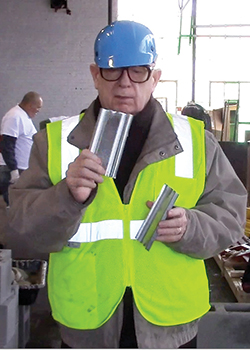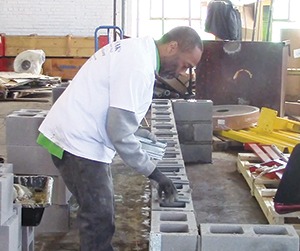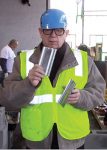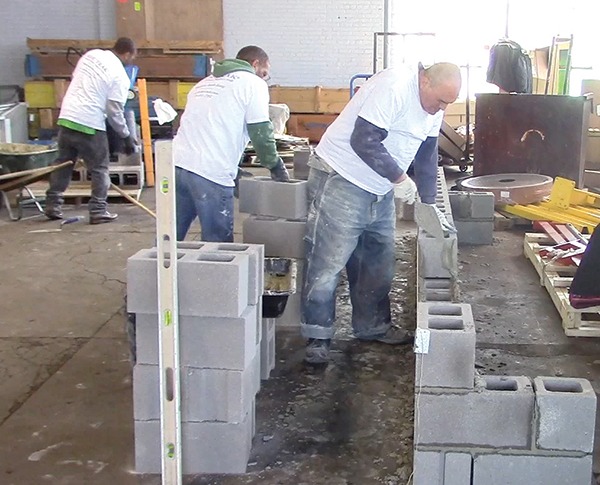Perspective
By John Claypoole
 Double your output and work half as hard! This article is about using Lean and a unique masonry product that will put cash in the pockets of the customer, the general contractor, the architect, the masonry contractor, the block layer, the material handler, the laborer and the supplier.
Double your output and work half as hard! This article is about using Lean and a unique masonry product that will put cash in the pockets of the customer, the general contractor, the architect, the masonry contractor, the block layer, the material handler, the laborer and the supplier.
While growing up in a small town outside of Pittsburgh, Pa., in the 1950s and ‘60s, I was saturated with a daily harangue of negative energy from my family of three generations of masons and masonry contractors. The essence of this pain was the constant complaint that each job was losing money from a wide range of sources— absenteeism, waiting for materials, waiting for other subcontractors to finish their work, arguments with the general contractor or his field superintendent regarding poor productivity, stress of not getting paid, and so on. In the Lean world, this is all considered waste.
Although a few of my brothers chose to pursue the masonry profession, I chose to go to engineering school, in hopes that one day I could possibly engineer a solution to transform this industry. Little did I know that, on the other side of the state, near Philadelphia, I would meet a man 40 years later who had the same vision and had obtained a patent that would do exactly that. His name is Dan Coccagna. I used Lean principles to transform Dan’s product into the powerful tool it is today.
Lean is the set of methodologies that evolved from Taiichi Ohno and the Toyota Production System, used throughout the world in manufacturing, hospital administration, insurance agencies and construction. Lean is all about eliminating waste in any process that reduces lead times and cost from the start of the process to the end.
The tool I will be describing here, that will double your production and let your installation crew work half as hard, is called “One Piece Flow.” Dan’s patented product allows “One Piece Flow” to work in masonry construction.
 Dan designed and patented a 0.018-inch-thick, galvanized steel, roll-formed, 4- x 6-inch spacer that is laid across each center web of 4-, 6-, 8- or 12-inch CMU that holds a 3/8-inch mortar joint and keeps the block perfectly level. The name of the product is BlocTrak. The original intent was to improve the vertical and horizontal strength of a wall, while a truss and ladder wire are there for horizontal strength.
Dan designed and patented a 0.018-inch-thick, galvanized steel, roll-formed, 4- x 6-inch spacer that is laid across each center web of 4-, 6-, 8- or 12-inch CMU that holds a 3/8-inch mortar joint and keeps the block perfectly level. The name of the product is BlocTrak. The original intent was to improve the vertical and horizontal strength of a wall, while a truss and ladder wire are there for horizontal strength.
I was introduced to Dan and learned of his product while working on a consulting project with a major roll forming company near Philadelphia. Having spent a lifetime in the world of masonry, and helping build my brothers’ masonry business using Lean methodologies, I saw a huge advantage to Dan’s product.
In Lean, the way a typical block layer has worked for centuries would be considered the Current State. Let’s consider a very simplified example. Assume that a job is stocked with materials and it is time to begin building the block walls. The size of this building is 80 feet long, 40 feet wide and 20 courses high, with no windows or doors.
In the Current State, this project requires a crew of four bricklayers, four laborers, a mortar mixer and a foreman/telehandler operator, for a total of 10 people. Each block layer can lay 125 block per day in an eight-hour shift. Doing the math, this building has 3,600 block. So the team of four block layers and sup-port can lay 500 block per day, and in theory the project will take 7.2 days. However, with waste and delays, it actually takes them 10 days.
To start the day, the telehandler operator sets the material on the scaffold, and the laborer brings mortar and block to the block layer as he works along the wall. For years, the typical method has been for each block layer to build corners first, pulling a string to maintain course height and levelness. Then the block layer turns and loads his trowel with mortar, lays the mortar down on the top of the previous course, turns and picks up a block, turns and picks up some more mortar to butter the end of the block, places the block down on the mortar, presses it into place, taps it down to the string height, scrapes off the excess and throws it back on the mortar board.
Let’s consider this process using “One Piece Flow.” The crew will consist of one journeyman bricklayer, one apprentice bricklayer, one laborer, the mortar mixer and a foreman/telehandler operator. This is a total of five people. You will be amazed at what this five-man team can do using the following method with the BlocTrak spacer:
- The material handler lays a BlocTrak spacer across each block’s center rib, moving down the course in front of the journeyman block layer. Then he goes back to stocking mortar and block.
- The apprentice then moves down the wall, placing mortar with his trowel on the front and rear top edge of the block, allowing 30 seconds per block.
- The journeyman follows and picks up an 8-inch CMU, butters one end with mortar and sets it so each end of the block is resting on the BlocTrak spacer. He then presses the block down, resting it on the BlocTrak spacer, maintaining a 3/8-inch mortar joint, also allowing 30 seconds per block.
The three-person team repeats this process down each course. Though the cycle time is 30 seconds per block per person, all three people are doing the 30-second cycles at the same time, so the cycle time remains 30 seconds, not a cumulative 90 seconds, per block.
This rate is two block per minute. Say the team takes a 15-minute break every hour, laying a total of 90 block per hour. Even if the team worked seven hours instead of eight, at 90 block per hour that would be 630 block per day.
Given 3,600 block for the building divided by 630 block per day, it will take only six days with five people to complete the job, as opposed to 10 days with 10 people using the previous method.
The secret here is that the work is done in parallel, rather than independently, and the BlocTrak spacer’s positive stop for a 3/8-inch mortar joint with structural integrity allows this to occur.
Now let’s look at the monetary savings, assuming the following pay rates:
Journeyman = $28.00/hour
Apprentice = $18.00/hour
Laborer = $15.00/hour
Mortar Mixer = $12.00/hour
Foreman = $32.00/hour
Under the Current State, the cost per day for the 10-person crew is $1,728/day. That comes to $17,280 for the 10-day job. Under “One Piece Flow,” the cost would be $840/day, or $5,040 for the six-day job. The total savings is $12,240, less the cost of the BlocTrak spacer.
So the next time you bid a Job and the general contractor, owner or architect asks you to value engineer a job or cut your price, offer up BlocTrak as a solution.
John Claypoole can be reached at optlean@gmail.com or (630) 747-6627. He has created a Youtube video which shows the use of BlocTrak web spacers and One Piece Flow. For product, pricing and distribution information, contact Dan Coccagna at UicBloctrak@gmail.com or (215) 677-2650.

